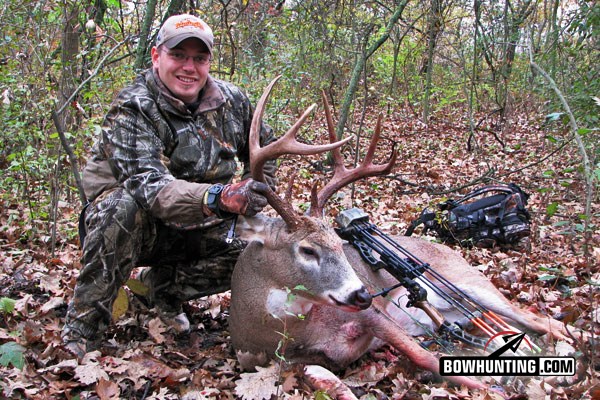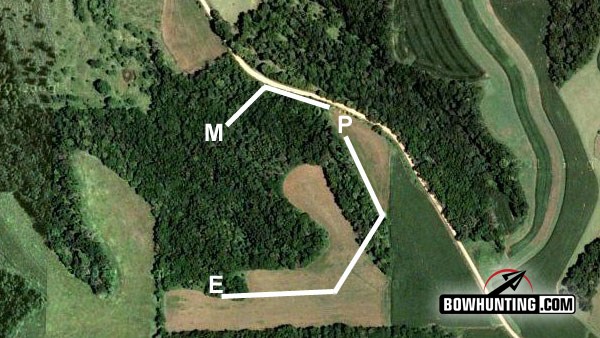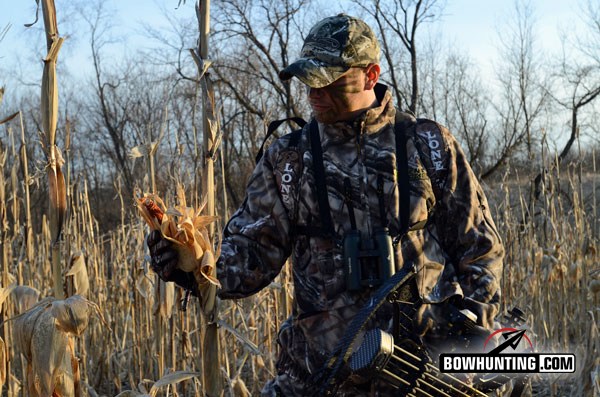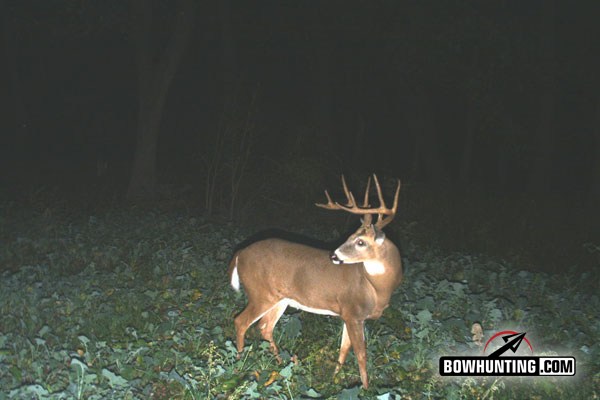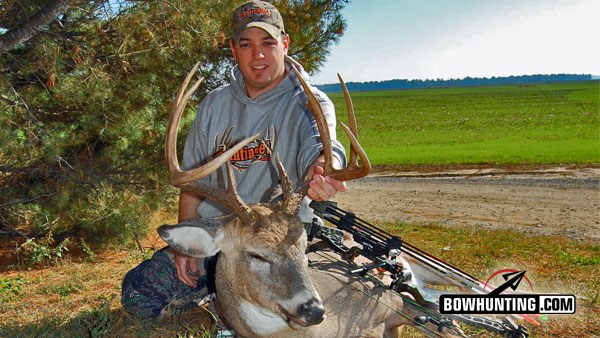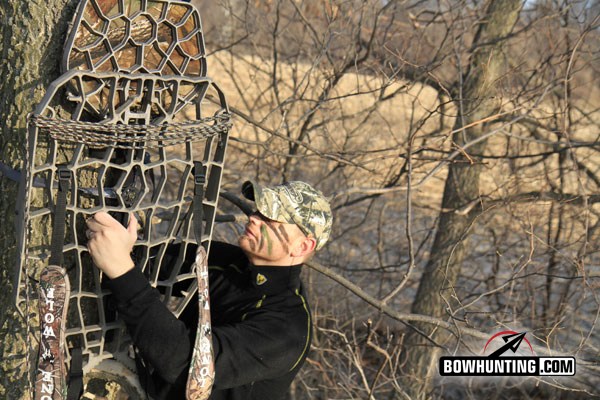LAST UPDATED: May 8th, 2015
It’s that time of year again where many of us are finishing up our final treestand preparations for the fast approaching season. While many bow hunters are simply checking the condition of stands that have been in place for years, others are studying topographic and aerial maps, checking deer sign and trying to formulate a plan that will help them be successful. When it comes to picking out your stand locations I’ve found it helps to determine if you’re looking for a morning location or an evening location.
By and large one of the biggest mistakes I see novice hunters make is hunting stand locations at the wrong times. Unfortunately for many of these hunters, they often don’t realize what’s going on until it’s too late. This is primarily due to the fact that they are spooking deer that they may never see or hear.
Keep in mind that some of the strategies I’m about to talk about are not fool proof.These are more of a general guideline that may help you get close enough for a shot, or at least determine the exact spot you need to be in order to make something happen this season.
MORNING STANDS
As a general rule of thumb, try to avoid hunting food sources in the mornings. Most whitetails are typically active during the night, much of which is spent feeding. In many cases whitetails will still be feeding in the hours leading up to sunrise which means you stand a good chance of spooking them on your way into your stand if you are trying to hunt over a food source (or too close to one). Walk into that food plot you spent hours working on this summer an hour before daylight and chances are you’ll spot several sets of eyeballs in your flashlight before you hear the telltale snort of a whitetail headed the other direction.
When it comes to avoiding food sources in the morning this also includes the entrance route to your stands. As a young hunter I always took the path of least resistance to my stand locations, which often meant marching through the direct center of a cut corn or bean field an hour before light. I would see eyes reflecting back in my flashlight and hear deer snorting at me on my walk in, but didn’t put two and two together as to why my morning hunts were often so unproductive until some years later. Looking back on those days I can’t help but laugh at my ignorance.
In order to maintain undetected try to slip into your stand using natural features such as creeks, ravines, and standing crops to your advantage. Take care to avoid walking field edges or areas within sight or earshot of a food source where you think deer may be. In most cases this is going to make your morning walk longer and more difficult than you’re used to, however it will almost surely increase your morning deer sightings.
So if not food sources, where should you hunt in the mornings? My personal favorite places to hunt during the morning are as close as I can get to a good bedding area. The intent is to catch deer coming off the feed sources at night and working their way back to safety to bed for the day. This tactic, although productive, does pose several risks that must be taken into consideration.
First, you need to set up between the food and the bedding area. If you set up on the wrong side of the bedroom you may find yourself playing more games on your phone than watching deer. When picking your stand location it is helpful to keep in mind the various food sources available to your local whitetails and hang several stand sets that you can utilize as the food sources change. When farmers begin taking in crops or acorns begin to drop the deer will begin utilizing different food sources and, in some cases, different bedding areas as well. A general rule of thumb is that you can never have too many stand locations to pick from.
Several years ago I was lucky enough to harvest this nice Illinois buck on the morning of October 19th. I was set up very close to a small bedding area that was surrounded by rubs when he appeared shortly after daylight. Mid to late October is a great time to catch bucks like this on their feet just late enough to get a shot at them.
Second, watch the wind carefully. I prefer to hunt on a cross wind, which is blowing perpendicular to both the bedding and feeding areas. This allows me to get into the stand without blowing out deer from the food source, yet doesn’t expose me to any deer that may happen to slip into the bedroom from another direction without me knowing. Of course I don’t always get this ideal wind which means that you’ll often have to pick a stand with the wind blowing at least partially into the bedding area. Be sure to hunt these stands very sparingly as you may only have one or two opportunities to hunt them on a non-perfect wind before they are blown out. However, if you’ve played your cards right once chance may be all you need.
Also, when picking a morning stand you have to consider not just your entrance but your exit as well. Don’t walk through the middle of the bedding area on your way back to the truck unless you enjoy not seeing deer from that stand. They key is to remain undetected so try exiting through those food sources you avoided in the morning, where you’re less likely to encounter a bedded buck.
This map of a property I used to hunt shows both morning “M” and evening “E” setups. For the morning hunts I would sneak down the road and into the woods in order to catch the deer moving off the feed fields back into the timber. Conversely, evening setups overlooking a standing bean field were very productive and allowed easy access without spooking deer bedded in the timber.
Finally, make sure you get into your stand early. Many of the mature bucks we’re hunting prefer to be off the food sources and headed back to bed well before daylight. If you’re walking into your stand 20 minutes before shooting light and run into a buck headed the same direction you may have just blown your chance. I like to be in my stand and ready to go at least an hour before shooting light, which often means leaving the truck a solid 2 hours before shooting light. This gives me time to cool off from that extra long hike, get my gear ready and let the woods settle back down before the sun peaks over the horizon. If you do nothing else, try getting into your stands much earlier than you do know and you’ll be surprised at how many more deer you will begin to see.
EVENING STANDS
During evening hunts I prefer to hunt close to, if not overlooking, a hot food source. The majority of your deer will be bedded down during the daytime and get up near dusk to begin feeding. In most cases they will begin to work their way towards food sources where they can chow down all night under the cover of darkness. Does will almost always be the first deer to enter a field at night, with most mature bucks not willing to expose themselves until the cover of darkness is close.
Finding a hot food source, like this standing corn field, is a great starting point for your evening hunts. After you’ve located the destination food source try to locate where the deer are entering the fields and set up on the down wind side.
Just like hunting during the morning you need to be aware of your wind direction and approach to the stand. Your wind should typically be blowing from your location towards the food source, or perpendicular to it. Make sure to avoid having your wind blow directly into the area you expect the deer to approach from (the bedding area). I know this seems like common sense, but you’d be surprised at the number of hunters who simply pick a stand on the edge of a field without paying attention to wind direction.
Approaching your stand doesn’t necessarily require as much work as your morning sets as walking through or on the edge of your agricultural fields is a great way to get into your stand undetected. The key is to avoid walking through any timber or locations you think deer may be bedded such as CRP, overgrown pastures, or any thick cover. If you just go trouncing through the middle of the woods on your way into your stand you may very well blow out the bedded deer before they have a chance to make their way to your food source.
For those of you with good agricultural fields or food plots, and unpressured deer, you may have good luck directly overlooking the food source. However, as many of us have found out, sitting directly on a food source may provide consistent sightings of does and small bucks but not the mature deer we’re after. This can be attributed to the fact that often times big bucks like to hang back in the woods and wait for the cover of darkness before coming out into the open. After all, they didn’t get that big by being stupid.
In these cases you’ll often find a heavy concentration of buck sign (rubs and scrapes) either just inside the field edge, or just outside of the bedding area. If you start seeing this increase in sign during mid-October but no buck sightings in the fields you may need to move your stand in closer to the bedding area and try to catch these bucks while they are staging. Staying mobile by either using a climbing stand or a set of Lone Wolf climbing sticks and hang-on stand can present a huge benefit to the bow hunter.
A great way to help you determine when the bucks are visiting your food sources is to use a trail camera. When it comes to trail cameras many hunters simply use them to gather an inventory of their deer herd, but not as actual scouting tools. If you can change your way of thinking and place your camera in strategic areas to tell you when deer are active it can help you figure out which places to hunt, and which places to avoid. If you are getting nothing but night time photos of your target bucks on field edges, try moving back 100 yards or so and see if you can surprise him before darkness falls.
If your trail camera is showing you a lot of buck activity in your food source after dark, you may need to move in closer to the bedding area in order to catch a buck on his feet during daylight hours.
Another overlooked evening set that often times coincides with staging areas are acorn drops. Often times I see people underestimating the power of acorns when it comes to whitetail hunting, which is a big mistake. There are few foods a whitetail enjoys more than a fresh crop of acorns, especially white acorns. If you can find a white oak that’s dropping acorns in between a bedding area and your primary food source you may just have found one of your best evening setups.
Several years ago I was fortunate enough to find a “magic oak” tree that was dropping acorns so often it sounded like it was raining. Located about 100 yards off a field edge this tree was attracting all of the local bucks who would eat and spend time sparring and interacting with each other before dark. After observing this movement from a stand that was just out of range I repositioned my Lone Wolf treestand to move in on the action and two nights later killed one of my best bucks with a bow.
After spotting this buck feeding on acorns under a huge white oak tree, I repositioned my Lone Wolf stand and shot him two nights later under the same tree. Mid to late October is a great time to locate, pattern, and harvest a good buck before the rut kicks in and he disappears from his core area.
BE READY TO MOVE
The above tips are simply a guideline that should help you get close to the deer you’re hunting and be able to observe their movements and patterns. With a little bit of luck (and some newfound skills) you’ll be able to hang a stand and kill a deer from it using these tips. However, that’s not always the case. Bowhunting is a game of inches and sometimes you’ll find that your stand is close but not close enough to give you a shot. When this happens you need to be ready to move.
Possibly the biggest mistake I see people make is hunting the same stand over and over again, hoping that someday a deer will walk within range. While there are certain stands that can produce year in and year out I’ve found that those “killing stands” aren’t as common as I would like. Sure, you may have SEEN a buck from this stand two years ago, and your uncle may have killed one with his gun a decade ago, but what is going on in your woods today? As food sources change from year to year and other factors including hunting and outside pressure change, deer will alter their movement patterns. In these cases you need to be ready to move.
I believe the #1 reason most hunters don’t move their stands more often is a combination of laziness and difficulty of moving stands. If you’re using a ladder stand you can pretty much forget about being mobile. Likewise, using screw-in steps and heavy steel hang-on stands can present quite the challenge as well. Having a good, lightweight treestand setup is the only way to go when it comes to staying mobile. My personal choice, as mentioned earlier, is a Lone Wolf hang-on stand and climbing sticks. With this setup and I can scout a staging area with fresh sign and be set up and hunting in less than 20 minutes. Often times this means the difference between success and failure.
Investing in a good light-weight setup like a Lone Wolf Alpha can pay dividends during the hunting season. If you’re not getting close enough for a shot in your current location, don’t be afraid to move! A wise bowhunter once said that the difference between a good stand and a great stand is sometimes less than 10 yards.
So if you find yourself in the position of seeing a lot of deer but not getting close enough for a shot, try moving your stand location and see what happens. After all, the window of opportunity for most of us is relatively small. Between weekends and a few “call in sick” days most of us only get to spend somewhere between 5 and 10 days in a stand while the hunting is good (end of October to mid November). If you don’t do it now, you may be waiting until next year to wrap your tag around a nice set of whitetail antlers.

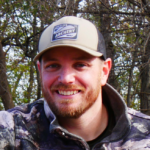 By
By 